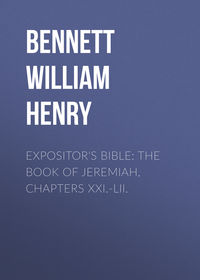
The Expositor's Bible: The Books of Chronicles
405
Cf. 2 Kings xii. 17, 18, of which this narrative is probably an adaptation.
406
xxv. 5-13, peculiar to Chronicles, except that the account of the war with Edom is expanded from the brief note in Kings. Cf. ver. 11b with 2 Kings xiv. 7.
407
In the phrase “from Samaria to Beth-horon,” “Samaria” apparently means the northern kingdom, and not the city, i. e., from the borders of Samaria; the chronicler has fallen into the nomenclature of his own age.
408
For the discussion of the chronicler's account of Ahaz see Book III., Chap. VII.
409
So R.V. marg., with LXX., Targum, Syriac and Arabic versions, Talmud, Rashi, Kimchi, and some Hebrew manuscripts (Bertheau, i. 1). A.R.V., “had understanding in the visions” (R.V. vision) “of God.” The difference between the two Hebrew readings is very slight. Vv. 5-20, with the exception of the bare fact of the leprosy are peculiar to Chronicles.
410
Cf. Ezek. xxvi. 9.
411
Pliny, vii. 56 apud Smith's Bible Dictionary.
412
Num. xviii. 7; Exod. xxx. 7.
413
Kimchi interprets “those days” as meaning “after the death of Jotham.”
414
The reference to the wall of Ophel is peculiar to Chronicles: indeed, Ophel is only mentioned in Chronicles and Nehemiah; it was the southern spur of Mount Moriah (Neh. iii. 26, 27). Vv. 3b-7 are also peculiar to Chronicles.
415
This is usually understood as Nisan, the first month of the ecclesiastical year.
416
xxix. 3-xxxi. 21 (the cleansing of the Temple and accompanying feast, Passover, organisation of the priests and Levites) are substantially peculiar to Chronicles, though in a sense they expand 2 Kings xviii. 4-7, because they fulfil the commandments which Jehovah commanded Moses.
417
Exod. vi. 18, 22; Num. iii. 30, mention Elizaphan as a descendant of Kohath.
418
So Strack-Zockler, i. 1.
419
Lev. i. 6.
420
According to 2 Kings xviii. 10, Samaria was not taken till the sixth year of Hezekiah's reign. It is not necessary for an expositor of Chronicles to attempt to harmonise the two accounts.
421
Cf xxx. 11, 18.
422
xxx. 14; cf. 2 Kings xviii. 4. The chronicler omits the statement that Hezekiah destroyed Moses's brazen serpent, which the people had hitherto worshipped. His readers would not have understood how this corrupt worship survived the reforms of pious kings and priests who observed the law of Moses.
423
Cf. xxix. 34, xxx. 3.
424
Lev. xv. 31.
425
So Bertheau, i. 1, slightly paraphrasing.
426
A.R.V., with Masoretic text, “the priests the Levites”; LXX., Vulg. Syr., “the priests and the Levites.” The former is more likely to be correct. The verse is partly an echo of Deut. xxvi. 15, so that the chronicler naturally uses the Deuteronomic phrase “the priests the Levites”; but he probably does so unconsciously, without intending to make any special claim for the Levites: hence I have omitted the word in the text.
427
xxxii. 2-8, peculiar to Chronicles.
428
xxxii. 30.
429
xxxiii. 11-19, peculiar to Chronicles.
430
So R.V.: A.V., “among the thorns”; R.V. marg., “with hooks”, if so in a figurative sense. Others take the word as a proper name: Hohim.
431
Ezek. xviii. 20.
432
Peter iv. 18.
433
Ezek. xviii. 21-23.
434
Psalm cxxx. 4, probably belonging to about the same period as Chronicles.
435
1 Chron. xxiii. 26, peculiar to Chronicles.
436
2 Chron. vii. 5. The figures are peculiar to Chronicles; 1 Kings viii. 5 says that the victims could not be counted.
437
Jehoiachin. The ordinary reading in 2 Kings xxiv. makes him eighteen.
438
2 xxxvi. 6b, peculiar to Chronicles.
439
Mostly peculiar to Chronicles.


